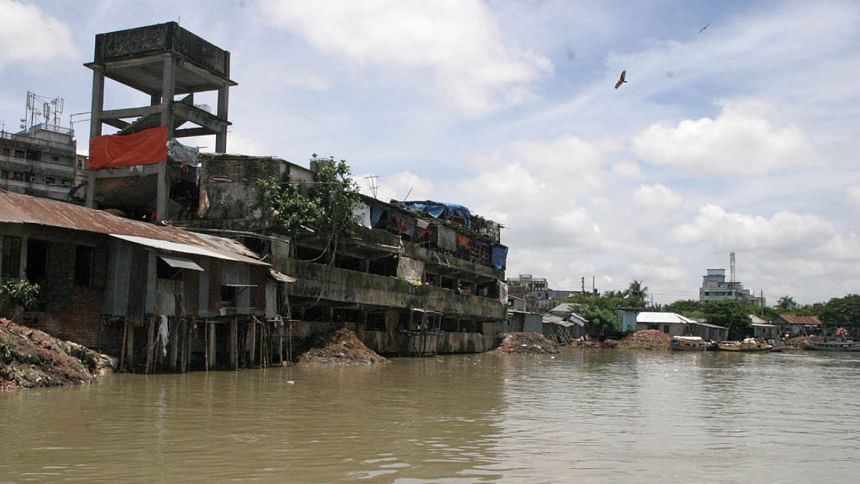Encroachers turning Turag river into a canal (video)
The encroachment of the Turag river continues unabated as more and more land around the once mighty river continues to be taken by illegal establishments.
One of the reasons facilitating this encroachment is the faulty demarcation of the river leading to a worsening of the situation on both banks.
Of the more than 2000 pillars erected in 2013 to demarcate the boundaries of the Turag river, only about 29 of them are in the proper place, according to studies by the Bangladesh Poribesh Andolon (Bapa).
This faulty demarcation has thus led to an indirect legitimisation of the encroachment that is rampant, according to Bapa general secretary Dr Abdul Motin.
The High Court in 2009 in a landmark ruling directed the government to demarcate the original boundaries of the Turag river and start setting up pillars on the boundaries to save the river from encroachment.

In 2013, soon after the pillars had been constructed and the government had formed a taskforce to save this river from encroachment, Bapa and the Bangladesh Inland Water Transport Authority (BIWTA) both concluded that the placement of these had been incorrect.
Not only do these pillars still stay in their faulty positions, due to neglect and lack of maintenance, now they are crumbling.
Dr Abdul Matin, also a member of the taskforce, says that despite clear directives from the court, majority of the pillars were constructed in the wrong places.
The High Court in its ruling, which was later upheld by the Supreme Court, clearly defined what constitutes a river.
“There has to be a riverbed, a foreshore and then the bank of the river – the area of the river constitutes upto 50 metre into the banks,” says Dr Abdul Matin.
“Only 1.45 percent of the pillars constructed are in the proper place. The others were built in the foreshore and sometimes even in the middle of the river,” he says.
BIWTA, which was directed to demarcate the river, also found that the demarcation of the Turag was faulty.
“We submitted our reports to the taskforce – they conducted their own research to verify our findings, and came up with a report also similar to ours,” Dr Matin says.
But it seems that the pillars have been built saving the encroachers. Bapa reports that around 5 crore 23 lakh square feet of river area in total on both sides of the river has already been encroached or is in the process of being so.
Going along the banks of Turag, it is apparent how blatantly the process of encroachment is continuing. The Turag is losing its land to establishments in the forms of schools, universities, clinker factories, restaurants and buildings.
Due to the faulty pillars, encroachers are at times getting away by saying that the encroached land is outside of the demarcation.
The incorrect demarcation adds to another step of the government’s failure to save the Turag, adding to a long list of faulty implementation.
Dr Ishrat Islam, professor and head of the Urban and Regional Planning department of the Bangladesh University of Engineering Technology (Buet) says,“We need to remember that filling of these rivers is completely illegal. The Detailed Area Plan clearly specifies that no establishments can be made on these rivers. Then the High Court also ruled the same and asked them to set up pillars. But the encroachers are completely disregarding this.”
If this continues unchecked, the Turag will be no more than a mere trickle of its mighty past. There have been recent drives to recover land, but in the end, not much has changed. Encroachment continues unabated.
Environmentalists and activists think that since there are clear laws and court rulings regarding the matter, it would not be difficult to recover the encroached lands and stop further encroachment if the government took proper initiatives.

 For all latest news, follow The Daily Star's Google News channel.
For all latest news, follow The Daily Star's Google News channel. 



Comments